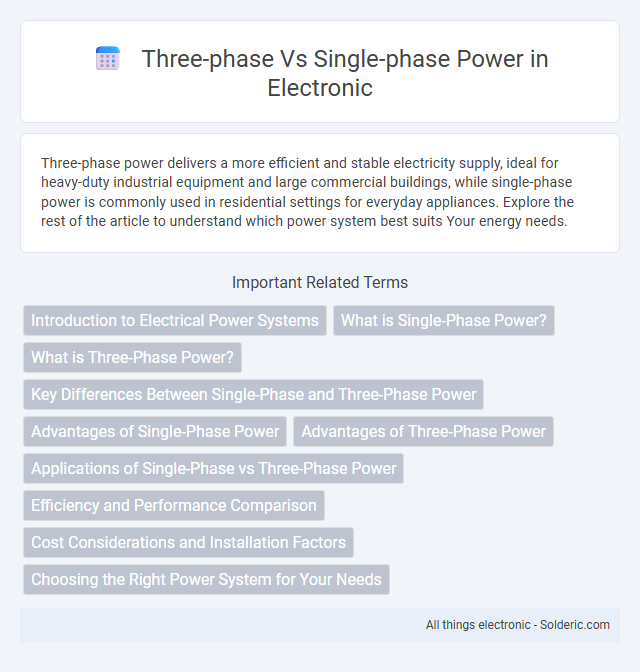Three-phase power delivers a more efficient and stable electricity supply, ideal for heavy-duty industrial equipment and large commercial buildings, while single-phase power is commonly used in residential settings for everyday appliances. Explore the rest of the article to understand which power system best suits Your energy needs.
Comparison Table
| Feature | Three-Phase Power | Single-Phase Power |
|---|---|---|
| Voltage Supply | Three alternating currents, each 120deg out of phase | Single alternating current |
| Power Delivery | Continuous and balanced power output | Power pulsates, less constant |
| Efficiency | Higher efficiency for power transmission and heavy loads | Less efficient for large loads |
| Common Applications | Industrial motors, heavy machinery, commercial buildings | Residential homes, small office devices, lighting |
| Installation Cost | Higher due to complexity and materials | Lower, simpler design and wiring |
| Power Capacity | Supports large power loads exceeding several kilowatts | Suitable for smaller power loads, typically under 10 kW |
| System Complexity | More complex wiring and equipment | Simpler setup, easier to maintain |
Introduction to Electrical Power Systems
Three-phase power systems deliver electric power using three conductors carrying alternating currents offset by 120 degrees, offering consistent and efficient energy transfer ideal for industrial and large commercial applications. Single-phase power uses one alternating current waveform and is commonly found in residential settings due to its simplicity and lower installation cost. Your choice between three-phase and single-phase power depends on the scale of electrical load and the necessity for stable voltage and power efficiency in your system.
What is Single-Phase Power?
Single-phase power uses a single alternating voltage wave to supply electrical energy, typically found in residential and light commercial applications. It provides consistent voltage but can experience power drops with heavy loads, limiting efficiency for large equipment. Your home appliances generally rely on single-phase power for steady and reliable operation.
What is Three-Phase Power?
Three-phase power is an electrical system that uses three alternating currents, each set 120 degrees apart, providing a continuous and balanced power supply ideal for industrial and commercial applications. This setup delivers more power efficiency and stability compared to single-phase power, which uses only one alternating current. Understanding three-phase power can help you optimize energy usage and enhance the performance of heavy machinery and large electrical loads.
Key Differences Between Single-Phase and Three-Phase Power
Single-phase power delivers electricity through one alternating current (AC) waveform, typically used in residential settings for smaller loads, while three-phase power uses three separate AC waveforms offset by 120 degrees, providing a more efficient and consistent power supply for industrial and commercial applications. Three-phase systems offer higher power capacity, smoother power delivery, and improved efficiency, making them ideal for heavy machinery and equipment, whereas single-phase is simpler and sufficient for most home appliances. Understanding these differences helps you choose the appropriate power system to meet your electrical demands and improve overall energy performance.
Advantages of Single-Phase Power
Single-phase power supplies are simpler to install and maintain, making them ideal for residential and light commercial applications. They offer consistent voltage levels suitable for most household appliances and smaller machines, ensuring reliable operation without the complexity of three-phase systems. Your electrical setup benefits from lower initial costs and easier troubleshooting, which enhances overall convenience and accessibility.
Advantages of Three-Phase Power
Three-phase power offers higher efficiency and better performance for industrial and commercial applications by delivering consistent power flow and reducing power pulsations. It enables the use of smaller, less expensive wiring and transformers compared to single-phase systems, leading to cost savings in infrastructure. Three-phase systems also support heavier electrical loads and provide smoother operation for motors, increasing equipment lifespan and reliability.
Applications of Single-Phase vs Three-Phase Power
Single-phase power is commonly used in residential and light commercial applications where the electrical load is relatively low, such as lighting, heating, and small appliances. Three-phase power is preferred in industrial and large commercial settings because it provides a more efficient and reliable supply for heavy machinery, large motors, and extensive HVAC systems. Your choice between single-phase and three-phase power should align with the scale and demands of your electrical equipment to ensure optimal performance and energy efficiency.
Efficiency and Performance Comparison
Three-phase power systems deliver higher efficiency and smoother performance compared to single-phase systems due to balanced power delivery and constant energy transfer. Industrial applications favor three-phase power for its ability to power heavy machinery with less electrical loss and reduced heat generation. Single-phase power suits residential or low-load environments but experiences voltage dips and lower efficiency under high-demand conditions.
Cost Considerations and Installation Factors
Three-phase power systems generally have higher initial installation costs due to more complex wiring and equipment requirements but offer greater efficiency and lower operational costs for large-scale industrial applications. Single-phase power systems are less expensive to install and suitable for residential or small commercial use, with simpler infrastructure and reduced material expenses. Choosing between the two depends on the power demand, where single-phase minimizes upfront costs for lower loads, while three-phase provides cost savings in energy efficiency and capacity for higher loads.
Choosing the Right Power System for Your Needs
Three-phase power systems deliver consistent voltage and higher efficiency, making them ideal for industrial and commercial applications requiring heavy machinery and large motors. Single-phase power is typically sufficient for residential settings with lower power demands and simpler electrical loads. Evaluating the scale of energy consumption, equipment requirements, and cost considerations helps determine the most suitable power system for specific needs.
three-phase vs single-phase power Infographic

 solderic.com
solderic.com